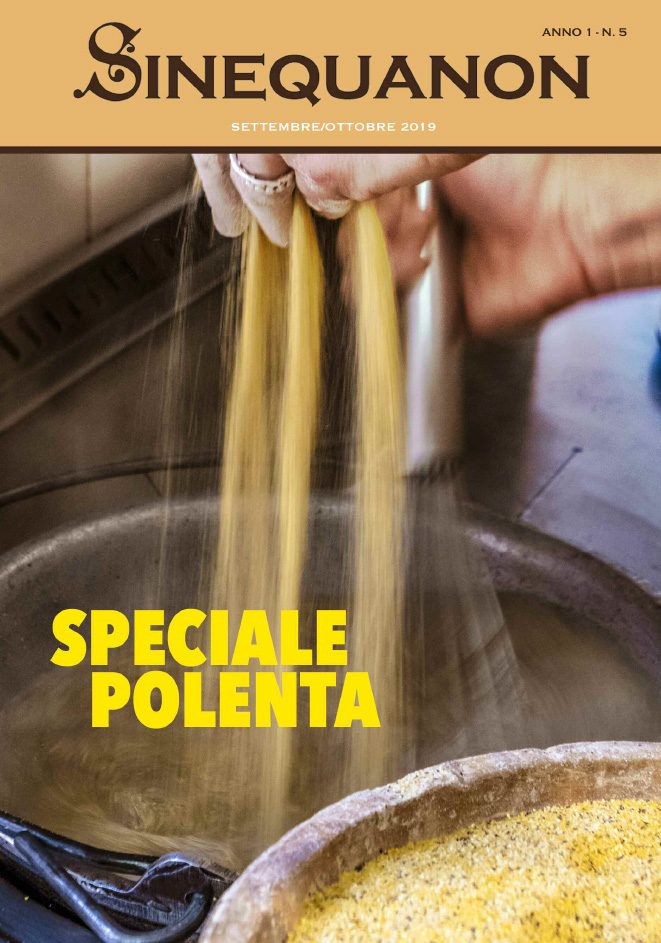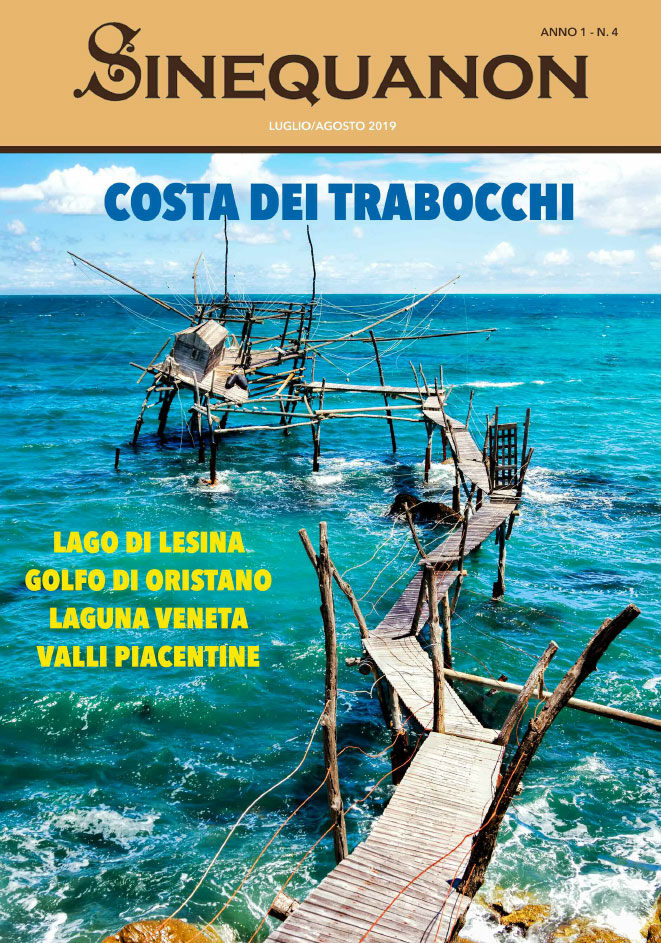English, Travel, Travelogues
ENNIO CAVALLI
Weimar
Church of St Peter and St Paul
PHOTOS: GESKE, DRESLER, SCHUCK, CRE ART, FULDA
I visited many beautiful cities before I came to Weimar, the city of Goethe. I?ve seen Finland in autumn, all gold and shadows of beaten iron, from Helsinki to the Lapland. I experienced the forest of dirty lamps that spray diamond dust over the valleys of Damask in the night. I?ve felt the strength of the sequoias of Muir Woods that form a wall with the Tamalpais mountains north of San Francisco — immune, epic history from small seeds no bigger than acorns. I?ve been surprised to see the word ?Hollywood? from Century City rising above the LA smog. I?ve glimpsed London from afar, all castles and quarters — Windsor, Hampton Court, Hampstead (that field where the Court judges met to continue their deliberations during the Plague). Now Weimar, last year designated the European culture capital for 1999, still undergoing restoration, broken after the reunification of Western and Eastern Germany.
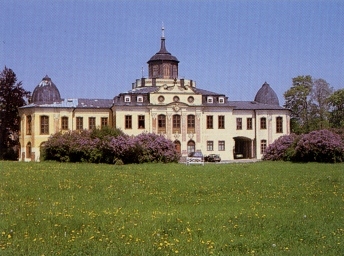 Belvedere Palace
Belvedere PalaceI owe these experiences to Enzio Biagi, or rather to the trips made in his company with other colleagues, ably ?directed? by Anna Drugman. Opportunities, sometimes, to present this or that new book by the great journalist. For me, that is how Weimar remains, tied to an Italy watched by Europe, or perhaps tied to the book ?Cara Italia? (Dear Italy), which Biagi presented there, in Turingia, in the heart of forgotten Germany. With more than a thousand years of history behind it, Weimar jealously guards the ?other half? of the deeds and misdeeds of recent European history. Suddenly overwhelmed by construction workers and pylons, without the need for urban revolution, small but made big by history, Weimar is ready for the third millennium. ?Where else can one still find every good thing in a place so small?? asked Goethe of his friend and secretary, Eckerman, in 1823. Yes, Goethe. They say that Weimar epitomizes Goethe. Not just Goethe, however. Cradle of classic Germanism, it is a city tied to the trials and tribulations of history.
 Tiefurt Palace
Tiefurt PalaceIt was here, in 1919, that the first German Republic was born. Then came Hitler, in 1933. History written in the stars for Goethe, Schiller and Liszt. The grand painter of the 500"s, Cranach, lived out the last two years of his life here. Nietzsche died here in 1900. Weimar, the seat of Bauhaus, the institution directed by Walter Gropius that revolutionalized architecture and design in the twentieth century, with the help of artists such as Paul Klee, Kandisky, Laszo Moholy-Nagy. The 1999 is not only the 250th year since Goethe"s birth. 240 years ago, Schiller was born here, 80 years ago, Bauhaus and the proclamation of the Republic. The first document bearing the city"s name is dated 1100 years ago. Ten years before, the Wall came down.
Entry into Weimar should be made towards the Frauenplan, where Goethe"s house rests. Built in baroque style in 1709 by the treasurer, Georg Kaspar Helmershausen, it quickly became the most illustrious house in the city. Duke Carl August gave it to Goethe in 1794 when he was a Minister of the little town. Goethe arrived in Weimar, at the request of the duke, in 1775. Since then, the 6,000 inhabitants have grown to 60,000. The presence of Goethe attracted Shiller, Wieland and Herder, quickly transforming the quarter into a center of ideas, creativity, culture, and opinion. ?For the first time, Germany has a capital of culture and literature,? wrote Madame de Stael in 1810. She took part as well in that circle.
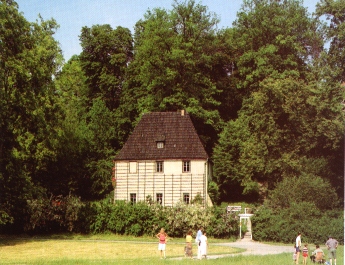 Goethe’s Garden House
Goethe’s Garden HouseGoethe"s house, already famous for works such as ?The Trials of Young Werther,? became the focal point for many cosmopolitan doings, as well as decor, memorabilia and general atmosphere — all gathered and displayed with sober elegance, ?not for arbitrary comfort,? as the head of the house wrote in 1806, ?but to spread art and science as far as possible.?<br><br>During the visit, together with Biagi, we were hit by the ?Welcome? inscribed in the wood of the floor at the door. A cordial salute in classic style. Now, that ?Welcome? has become a trademark, a tourist slogan, and one finds it on every imaginable piece of merchandise, even on plants and bottles. For Goethe, it represented the domestic translation of a language and a culture, (Latin and Italian, classic and Renaissance) upon which he founded his philosophy.
Goethe’s Cabinet in the Dwelling
House on FrauenplanArriving at the top of the wood staircase with large steps inspired by the Roman Palladio, we see a half covered stand with a sign advising us that the Prime Minister of the Weimar Court"s uniform is undergoing restoration. Still there, however, is the large loden travelling cloak with velvet collar and a high pointed hood. Symbol enough, for us. We are, after all, in the home of a traveller, a learned man, always ready to jump in the carriage with his leather bag in hand, leaving something of himself behind, to meet someone new. Like the time he visited Italy, and stayed for two years.
In his house three thousand books remain, along with pieces of lava he collected in Etna. Preserved in the house there is a collecting of atlases, and a collection of fossils. Trinkets, chalk, Greek religious medallions, artwork that brings to mind a spirit of the world, far away and nearby at the same time. Imperial symbols, like the bust of Giunone Ludovisi resting on its plinth in the receiving room of this poet of the state. Sculptures, paintings, copies of neoclassic symbols. The Giunone room wouldn"t be complete without the piano, in front of which, more than once between 1821 and 1830, sat Mendelssohn.
The Berlin born composer, Carl Friedrich Zelter presented him to Goethe.
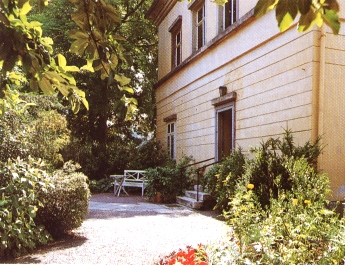 Liszt’s House
Liszt’s HouseGoethe"s studio, furnished very simply in the back of the house, remains as it was at the time of his death. The pen rests still in its inkpot, The opaque wood floor, the elegant seats with their lyric motifs carved into the backs, a funny looking trash can sitting on a wicker tray, all remain untouched by the passing years. It"s amazing to think that is this very room, open and filled with sunlight, Goethe put the finishing touches to ?Faust,? ?Ifigenia,? and ?Egmont,? as well as the autobiography ?Poems and Truth.? At the end of a narrow corridor lies his bedroom with its red fir bed up against a wall. A lounge chair sits some distance away, and the floor is made of separated beams. Small and dark, more a nook than a room — a secret office. The bellows that gave breath to dreams and obsessions, that made Goethe"s nights come alive must still be hidden somewhere in this room. Dark, endless lairs found in houses such as these are perhaps the most serene places to die, away from the pomp of the world.
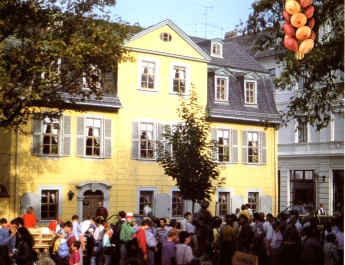 Schiller’s House
Schiller’s HouseGoethe died here in 1832, 82 years old, having just finished the second part of ?Faust,? a five act work that was released the same year. Kafka, visiting the house in 1912, was embarrassed to feel a strong undercurrent of emotion. ?An immediate recognition . . . a sense of participation in every past life up to the present.? We finish our tour in the rococo room of the library of Duchess Anna Amalia, in Democracy Square. Goethe was the superintendent from 1797 until his death. He opened the collection to the public, convinced that by doing so he could access that ?great capital which, silently, produces incalculable returns.? Whoever would like to continue the journey (?What is travelling? Travelling is joyful life,? as he said) should know that the ?Goethe Road,? free and full of interesting stops is back in the new Germany. It runs from Frankfurt, his birthplace, to Offenbach, where he spent a summer with his fiancee, Lili Schonimann, to Lipsia, ?little Paris,? to Dresda, where he happily left his signature on the guestbook.






